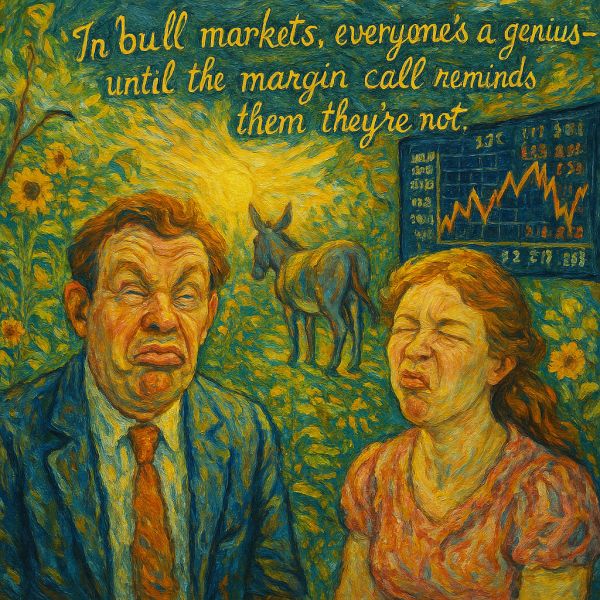Michael Burry Stock Market Crash: Dire Warnings, Duller Outcomes
April 19, 2025
He made one of the greatest contrarian trades of all time—betting against the synthetic optimism of a bloated housing market while the world chugged champagne on the Titanic. Then came Hollywood, a best-selling book, and a mythos wrapped in brooding silence and obscure tweets. Michael Burry became finance’s reluctant oracle.
But here’s the paradox: ever since The Big Short, the bite hasn’t matched the bark. The man who once saw through the fog has been screaming “incoming!” at every cloud since. The real question isn’t “Was Burry right?” It’s deeper: What happens when the crowd anoints a prophet before the prophecy unfolds?
Post-2008: Broken Clock or Delayed Echo?
After 2008, Burry continued to press the red button. Again. And again. But the financial system didn’t implode—it shape-shifted. Liquidity rained from above. Risk got monetised. And the crowd, too scared to blink in 2008, leaned into every dip like it was a discount sale.
In 2010, Burry warned of a “mutating bubble,” citing quantitative easing as monetary morphine masking terminal disease. Sounded logical. But the markets kept levitating. QE didn’t kill faith—it fueled FOMO. No crash. No reckoning. Just another leg up.
Then in 2013, he shorted the market, calling the rally a steroid-inflated illusion. But the crowd didn’t care. ZIRP was love. Buybacks were gospel. Stocks soared. Again, no collapse. Just more disbelief getting crushed under a grind-up bull.
It wasn’t that Burry misdiagnosed the disease—he misread the patient’s psychology. The market doesn’t respond to fundamentals alone; it reacts to belief. And belief, when amplified through policy, media, and memes, becomes a stronger force than logic.
From Seer to Siren: When Warnings Become White Noise
By 2019, Burry had fully morphed into the boy who cried crash. “Economic hurricane.” “All asset bubbles.” “Cryptocurrency collapse.” The themes were consistent—debt, leverage, and delusion. But the timing? Always off.
His infamous 2021 “mother of all crashes” warning about crypto? Missed. Bitcoin dipped, then recovered. Ethereum tanked, then reawakened. Meanwhile, the world adapted. Burry’s warning was too macro, too binary, ignoring the messy, volatile middle where innovation and implosion often dance together.
The irony is brutal: Burry’s warnings are often directionally right—fiat debasement, tech overvaluation, monetary excess. But in markets, being early can feel like being wrong. If you scream before the avalanche, but it doesn’t fall for five years, the crowd stops listening. And when it finally comes? They call it “unforeseen.”
The Power of Chance: Broken Clock Logic in a Noisy Market
The cliché holds: even a broken clock is right twice a day. In markets, this isn’t wisdom—it’s statistical noise. Given enough predictions, someone will inevitably nail a moment. That doesn’t make them a prophet. It makes them lucky. Or loud. Sometimes both.
Burry’s 2008 win? Real. Precise. Ruthless. But even sniper shots can be flukes if they don’t repeat. Since then, his crash calls have ricocheted off reality. Post-2008, the pattern hasn’t been insight—it’s been echo. Markets up, Burry calls a crash. Again. And again. However, markets tend to climb anyway, then correct on their own terms. The cycle continues. The accuracy doesn’t.
Predictive success in financial chaos is rare, and staying right is far harder than being right once. Especially when ego inflates faster than returns.
History Doesn’t Repeat—It Provokes
Every crash is different—every recovery rhymes. The smart don’t predict them—they prepare for them. Buffett’s contrarian axiom is burned into market lore: buy when there’s blood. That’s not inspiration. That’s an instruction.
The crowd flees—the bold collect. In 2008, in 2000, in 1987—those who moved against the panic rode the wave back up. Crashes flush out noise. What remains? Opportunity in disguise. Not every falling knife is worth catching. But when value detaches from price, that’s when sharp minds and steel nerves strike.
Forget Sun Tzu quotes—real strategy is watching what the crowd refuses to see and acting before they sober up.
The Crowd: Dumb, Predictable, Dangerous
You can smell it before it breaks.
Uber drivers pitching altcoins. Your barber’s got a biotech tip. Gym bros bragging about buying dips in stocks they can’t spell. TikTok feeds loop the same FOMO hype. That’s not insight—it’s contagion.
This is the moment before the wave collapses.
History screams warnings. In 1999, the shoeshine boy gave stock tips. In 2007, your neighbor was flipping condos with zero-down loans. In 2021, Dogecoin millionaires were minted—then vaporized.
Crowd sentiment is not some esoteric metric. It’s measurable. Check the AAII Sentiment Survey, CNN’s Fear & Greed Index, or put/call ratios when euphoria spikes. Pair that with technical tools like the Relative Strength Index (RSI)—and when you see sentiment euphoric while RSI flashes red? That’s not a signal—it’s a flare.
This is when you sell. Or wait. Or short. Just don’t join them.
Because when fear floods every headline and retail panic dumps at market open? That’s when opportunity quietly walks in the back door.
As Jesse Livermore said, “It was never my thinking that made the big money. It was my sitting.” He waited. Watched. Let the crowd overextend, then take the other side.
Technical Tools: Signals Amid the Static
Price is speech.
Volume is tone.
Momentum is mood.
If you can’t read these, you’re not listening—you’re guessing.
Technical analysis isn’t fortune-telling. It’s recognising crowd behaviour in the chart’s bones. When markets enter monthly overbought ranges—RSI north of 70, MACD curling down, candles wicking off resistance—don’t wait for Jim Cramer’s blessing. The market is already whispering a reversal.
Dow Theory lives here.
Trend. Volume. Confirmation.
When the primary trend breaks—and both the industrials and transport indexes fail to confirm each other—it’s not a debate. It’s deterioration.
Watch support levels on weekly charts. When they crack, stops trigger, and forced selling begins. When they hold—on heavy volume—it’s often the first breath back from the abyss.
After the crash, don’t ask “Is it over?” Ask: What survived?
Scan for quality companies with durable balance sheets that sold off in the panic but not the fundamentals. That’s where Nicholas Barbon’s 17th-century wisdom kicks in:
“Cheap is dear if no buyers; dear is cheap if buyers plenty.”
Translation: price isn’t value. Demand is.
Action Steps: Outwit the Crowd, Use the Crash
- Track Sentiment, Not Hype
- Follow indicators: AAII, put/call ratios, Fear & Greed Index
- When bullishness peaks, prep to exit. When fear rules, prepare to enter.
- Watch Technicals Like a Predator
- Use RSI, MACD, Bollinger Bands, trendline breaks
- Confirm setups across timeframes—don’t trade isolated signals
- Use the Crash
- Build a crash list: quality assets you want at fire-sale prices
- Set alerts at levels of historical support or previous panic lows
- Scale in when volume spikes and VIX peaks, not when CNBC says “capitulation”
- Wait for Confirmation
- Look for bullish divergences on RSI
- Watch price break above resistance on strong volume
- Avoid knife-catching—buy strength emerging from weakness
Master the Crowd, or Be Consumed by It
Most investors don’t lose because they lack tools. They lose because they trust the crowd. They chase noise, crave consensus, and panic on cue.
Break that cycle.
Read the mood. Watch the signals. And when the herd rushes in one direction, walk the other.
Because in the end, markets don’t reward the loudest. They reward the quiet few who stayed calm, read the pulse, and struck when others blinked.
Crash as Catalyst: The Long Game Plays Itself
Crashes aren’t chaos—they’re reboots. Necessary. Ugly. Cleansing. What follows? Strength. Always has.
The 1929 abyss gave birth to the post-WWII boom. Black Monday in ’87 gave way to a roaring 90s. The dot-com implosion cleared the decks for Amazon, Google, and Apple. Every collapse wipes out froth. The strong emerge—the bold get in early.
Seneca had it right: healing begins when we stop denying the wound. The market doesn’t punish forever. It resets, recalibrates, and rewards patience.
The Bottom Line: Ride the Wave, Tune Out the Static
Michael Burry may have nailed 2008, but one hit doesn’t make a prophet. His more recent crash calls have fizzled, reminding us that market timing isn’t a repeatable science—it’s a gamble dressed in conviction. The obsession with doomsday predictions is a distraction from more pressing concerns. What’s real? The relentless rhythm of market cycles and the strategic advantage of buying when others are paralysed by fear.
Forget the noise. Track the tide. Markets, despite their volatility, tend to trend upward over time. Crashes aren’t endings—they’re resets. They shake out the excess and hand opportunity to those with the guts to act when panic sets in. If you’re armed with a contrarian mindset, a dash of technical awareness, and the patience to sit tight, crashes become launchpads—not pitfalls.
So don’t get hypnotised by bold headlines or cultish fear. Learn from the cycle, follow the underlying trend, and strike when blood hits the street. The real edge lies not in predicting the storm—but in surfing it. As Seneca might’ve put it: the path to greatness runs through fire, not forecasts.
Mental Marvels: Discovering Hidden Gems











